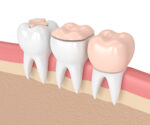
When it comes to dental restorations, choosing the right treatment is crucial for maintaining optimal oral health. Two common options for repairing damaged or decayed teeth are onlay restorations and crowns. Understanding the differences between the two can help you make an informed decision about which is the better choice for your specific dental needs.
Understanding Dental Onlays and Crowns
Before we explore the specific scenarios where one treatment prevails over the other, let’s briefly differentiate between dental onlays and crowns.
Dental Onlay
- An onlay is a conservative, minimally invasive dental restoration.
- It is designed to address damage or decay that extends beyond the biting surface of a tooth.
- Onlays are often fabricated in a dental laboratory using materials like porcelain, composite resin, or metal alloys.
- They are custom-made to fit precisely into the affected area, preserving as much healthy tooth structure as possible.
Dental Crown
- A dental crown, also known as a cap, encases the entire visible portion of a tooth above the gum line.
- Crowns are typically recommended for more extensive damage, such as severe decay, fractures, or after a root canal treatment.
- They provide comprehensive coverage and protection for the entire tooth, restoring its strength, shape, and appearance.
When is a Dental Onlay Preferred?
- Moderate tooth damage: Dental onlays are often recommended when a tooth has moderate damage or decay that extends beyond the biting surface but does not necessitate a full crown.
- Preserving healthy tooth structure: If the majority of the tooth is healthy and only a portion requires restoration, an onlay is a conservative option. This helps in maintaining the strength of the natural tooth.
- Aesthetic concerns: Onlay restorations, especially those made from porcelain or composite resin, can be customized to match the natural color of your teeth, offering a more aesthetically pleasing result.
When to Opt for a Dental Crown
- Extensive damage or decay: If a tooth has extensive damage or decay that affects a significant portion of its structure, a dental crown may be necessary for comprehensive restoration and reinforcement.
- Root canal treatment: Teeth that have undergone root canal therapy often require crowns to provide added strength and protection.
- Structural instability: In cases where a tooth is structurally compromised, a crown can help stabilize and support it, preventing further damage.
Choosing the Right Option
- Consideration of Tooth Function
Assess the role of the tooth in your bite and overall oral function. If the tooth is a molar responsible for chewing, an onlay might be sufficient. However, if the tooth plays a crucial role in biting or supporting adjacent teeth, a crown may be more appropriate.
-
Budget and Insurance Coverage
Consider your budget and insurance coverage. Onlays are often less expensive than crowns, and insurance coverage may vary. Discuss financial aspects with your dentist to find the most suitable option for your circumstances.
In the realm of dental restorations, the decision between a dental onlay and a crown is not one-size-fits-all. It depends on various factors, including the extent of damage, preservation of tooth structure, location of the restoration, strength requirements, and cost considerations. Consulting with your dentist is crucial for a personalized assessment and recommendation based on your specific oral health needs. Ultimately, the goal is to choose the option that not only restores your tooth effectively but also ensures the longevity and well-being of your overall oral health.

